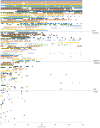Monitoring Adherence to Asthma Inhalers Using the InspirerMundi App: Analysis of Real-World, Medium-Term Feasibility Studies
- PMID: 35047915
- PMCID: PMC8757762
- DOI: 10.3389/fmedt.2021.649506
Monitoring Adherence to Asthma Inhalers Using the InspirerMundi App: Analysis of Real-World, Medium-Term Feasibility Studies
Abstract
Background: Poor medication adherence is a major challenge in asthma and objective assessment of inhaler adherence is needed. InspirerMundi app aims to monitor inhaler adherence while turning it into a positive experience through gamification and social support. Objective: We assessed the medium-term feasibility of the InspirerMundi app to monitor inhaler adherence in real-world patients with persistent asthma (treated with daily inhaled medication). In addition, we attempted to identify the characteristics of the patients related to higher app use. Methods: Two real-world multicenter observational studies, with one initial face-to-face visit and a 4-month telephone interview, were conducted in 29 secondary care centers from Portugal. During an initial face-to-face visit, patients were invited to use the app daily to register their asthma medication intakes. A scheduled intake was considered taken when patients took a photo of the medication (inhaler, blister, or others) using the image-based medication detection tool. Medication adherence was calculated as the number of doses taken as a percentage of the number scheduled. Interacting with the app ≥30 days was used as the cut-off for higher app use. Results: A total of 114 patients {median 20 [percentile 25 to percentile 75 (P25-P75) 16-36] years, 62% adults} were invited, 107 (94%) installed the app and 83 (73%) completed the 4-month interview. Patients interacted with the app for a median of 18 [3-45] days, translated on a median use rate of 15 [3-38]%. Median inhaler adherence assessed through the app was 34 [4-73]% when considering all scheduled inhalations for the study period. Inhaler adherence assessed was not significantly correlated with self-reported estimates. Median adherence for oral and other medication was 41 [6-83]% and 43 [3-73]%, respectively. Patients with higher app use were slightly older (p = 0.012), more frequently taking medication for other health conditions (p = 0.040), and more frequently prescribed long-acting muscarinic antagonists (LAMA, p = 0.024). After 4 months, Control of Allergic Rhinitis and Asthma Test (CARAT) scores improved (p < 0.001), but no differences between patients interacting with the app for 30 days or less were seen. Conclusions: The InspirerMundi app was feasible to monitor inhaler adherence in patients with persistent asthma. The persistent use of this mHealth technology varies widely. A better understanding of characteristics related to higher app use is still needed before effectiveness studies are undertaken.
Keywords: mHealth; medication adherence; patient participation; self-management; smartphone; technology assessment.
Copyright © 2021 Jácome, Almeida, Pereira, Amaral, Vieira-Marques, Mendes, Alves-Correia, Ferreira, Lopes, Gomes, Araújo, Couto, Chaves Loureiro, Santos, Arrobas, Valério, Todo Bom, Azevedo, Teixeira, Ferreira-Magalhães, Pinto, Pinto, Neves, Morête, Bom, Costa, Silva, Vasconcelos, Falcão, Marques, Mendes, Cardoso, Cidrais Rodrigues, Oliveira, Carvalho, Lozoya, Santos, Menezes, Gomes, Câmara, Alves, Moreira, Abreu, Silva, Bordalo, Alves, Lopes, Taborda-Barata, Fernandes, Ferreira, Chaves-Loureiro, Cálix, Alves and Fonseca.
Conflict of interest statement
The authors declare that the research was conducted in the absence of any commercial or financial relationships that could be construed as a potential conflict of interest.
Figures



References
-
- World Health Organization . Adherence to Long-Term Therapies: Evidence for Action. Geneva: World Health Organization; (2003). Available online at: https://digicollections.net/medicinedocs/#d/s4883e (accessed June 28, 2021).
-
- European Commission/MEDI-VOICE . MEDI-VOICE Report Summary. Project ID: 17893. European Union/European Commission, (2011). Available online at: https://cordis.europa.eu/project/id/17893/reporting (accessed December 31, 2020).
-
- Global Initiative for Chronic Obstructive Lung Disease . Global Strategy For Prevention, Diagnosis and Management of COPD. (2020). Available online at: https://goldcopd.org/gold-reports/ (accessed June 28, 2021).
LinkOut - more resources
Full Text Sources
Research Materials

